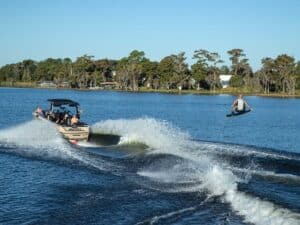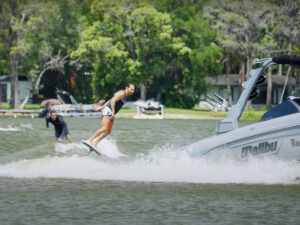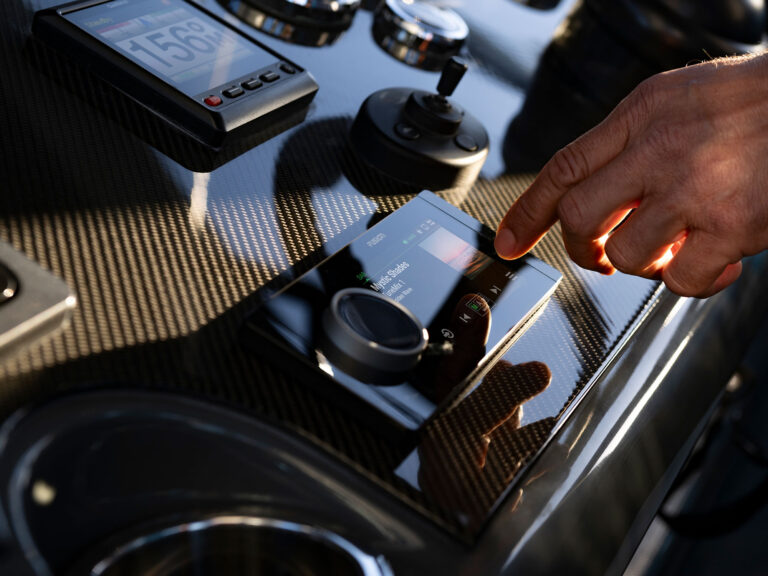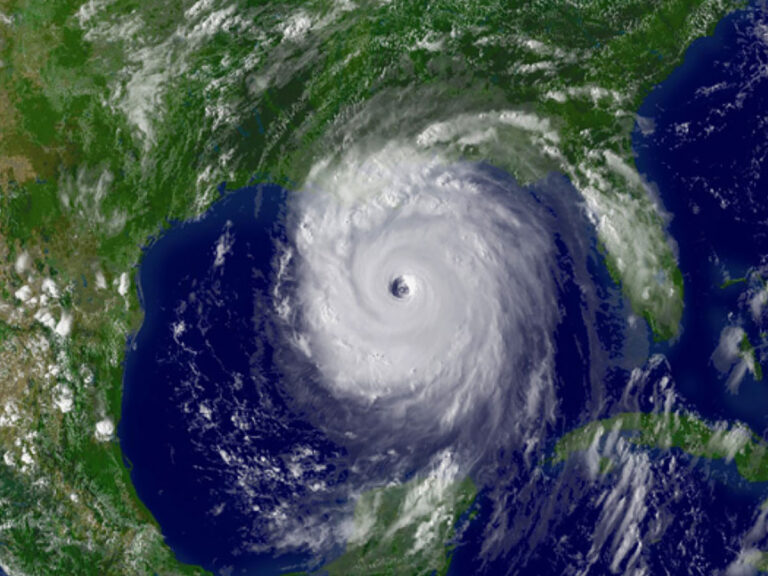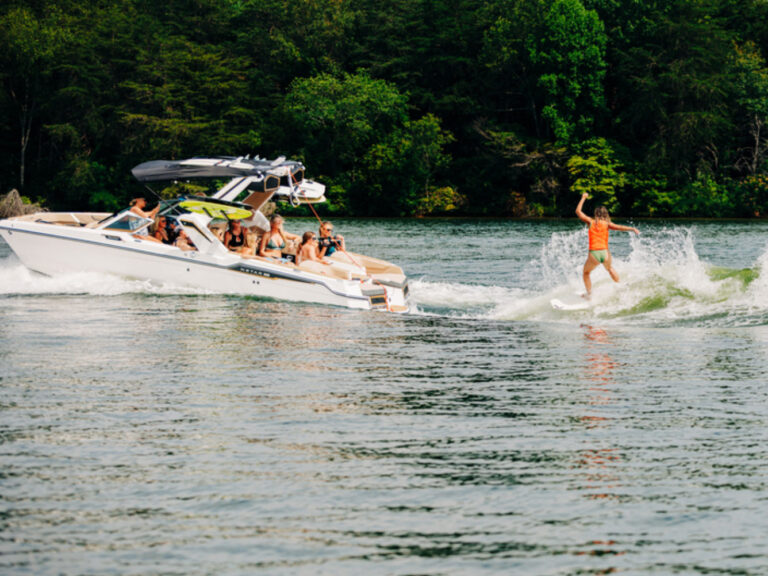We’re going to let you in on a little secret. You know all those shots we run of your favorite pros hovering miles above their extended pylons, getting more air than you ever thought was possible off a wake? Well, they’re probably not going that big off the wake. Don’t get us wrong. Guys go huge off the wake, but for the super aired-out moves, most often it’s pulled off the double-up.
So then, what’s a double-up? We’ll get really remedial here for you. A double up is the resulting extra-large peaky wave created where the wake from your boat’s original path intersects with the wake of your new path after you turn the boat in a path roughly the shape of a “P.” Actually, I hate to give a board company a plug, but look at the logo on a DoubleUP board and that will give you a good idea of what path creates a double up.
Driving the Double-Up
Your driver is a key part of the double-up. When driving the double-up, it is important to keep the speed up through the entire turn. When you go through the wake you want the boat to be the exact speed you normally ride at. Too slow and you’ll mush through the wake, and if the driver goes too fast or accelerates through the wake it can pull the rider out of his trick. The best advice is to listen to the engine and watch the RPMs.
Most riders like the driver to come back through the original path at a near 90-degree angle but Dave Briscoe, who teaches his students their first double ups at his Ski Away Ski School in Winter Haven, FL says that it is easier for a first-timer if you come through at about 45 degrees. After the rider can consistently hit the double up from that approach, you can eventually work up to, but never more than, 90 degrees. If you are left-foot-forward, have your driver give you a right double up which means he should turn the boat to his right. This will give you a heelside approach. Do the opposite if you are goofy-footed. Finally, Briscoe recommends that the driver heading off at 45 degrees for about 200 yards before turning into the double up. This way, the rollers aren’t sent down your path of the next run.
Some riders, like Charley Patterson, say they prefer a wider arc to the turn of the double up. Patterson says it gives him more setup time. He also says that a wider arc makes it easier for someone learning because they can time it better. Other riders like Gator and C.C. Roberts seem to prefer a constant turn because it slings them into the wake.
Patterson teaches beginners using a different, but equally popular approach. He says as the boat makes its final approach, edge out and let the rollers come to you. As the first peak comes by you, get in the trough right behind it and ride the trough in until that wake meets the one the boat is currently making. This technique ensures that you hit the peak. Don’t go over several waves to get to the double up. Patterson has his students use a normal progressive approach, eyeing where the wakes will meet and hitting it where the peaks come together to make a ramp.
Super double ups (triple ups)
Of course, with any extreme, there is the ultra extreme – and that’s the super double up. Super double ups build the wake up even bigger than the regular double up. Riders don’t do these too often because, as Cobe Mikacich explains, it’s tough to get in between the rollers to hit the super with much speed, but he goes on to add, “Super double ups are the bomb.” To drive a super, you first put a kink into your path – sort of a quarter turn, then straighten out and come around back through where you put the kink. The boat should kind of go through the side of the peak so the main wedge hits the wake where the rider will be.
Just Hit It
Getting the timing down to hit the double up right when it peaks is the hardest thing. The best way to get this timing is to first study what you are about to hit. Get your driver to do a double up. When the boat is coming back around, you’ll notice there will be four rollers you’ll go through. The first is a small, worthless one you can ignore. The second two are the big ones, one of which you’ll want to hit, and the fourth is another small one. Most riders hit the second roller (the first big one) but some go for the third. Cobe says he usually hits the third unless there are a lot of people in the boat and the boat has a big wake. If that’s the case, he goes for the second wake.
You’ll probably want to go at the first big one. Dave Briscoe says the easiest way to hit it is not to cut at the wake, but let wake come to you. Stay on the inside of the turn about a foot from the wake. As the boat goes through the rollers, go over the first, then turn the board toward the apex. What will happen is that the wave will move toward you and the peak will hit you. Because the wake is so big, it is wider than you are used to so if you cut at it, you’ll probably get there too early. You want to be launched off the wake right where it peaks up. Briscoe stresses to learn how to let the wake come to you. Start at one foot out, get it consistent, then move wider and wider until you can take a full cut at the wake and still hit it right.
Your First Tricks
After you hit it, do something with it. If you can consistently get good air off the double up, then try to do some hits where you control your board position in flight. Get air then practice getting the board flat in the air for the landing. Once you can do that, start off trying simple tricks like 180s or 360s. If you can already do these off the wake you can stall them out and do them with more style off the double up, and if you aren’t hitting them off the wake, they’ll come easier off the double up. The good thing about the double up is that it eliminates the pull of the boat. This makes it easier for rotational tricks. Without the double up you have to edge really hard and have a lot of pull on the boat. The double up gives you the height without the tight line. Another difference is the double up creates a really steep wake, so when you hit it, make sure you adjust your wake so the board will ride up and off the wake. If you are leaning too far forward you might mush through the wake instead of launching off it.
Advanced Tricks
After you do grabs and simple rotations and you are totally confident on your timing, then you can start to do inverts. A tantrum is a good first invert to learn off the double up because the steeper wake kicks you up and because you don’t hold an edge all the way through the wake. Gregg Necrason says he uses the double up to do some of his tricks – that it’s really good on tantrums and scarecrows but not on other tricks like a basic backside mobes or a Raley. He says it’s best on tricks that you need to go up more than you need to go out. It pops you up and makes it easier to float your tricks. Necrason says that toeside double ups are a little harder because the wake “bucks you weird.” To do a good toeside hit, Necrason recommends that you stand tall and keep your weight back somewhat. Overall, he says, “The double up gives you a little more time – that’s how I learned my Pete Rose, but once you get it down it’s fairly easy to move it to the wake.”

